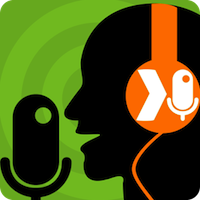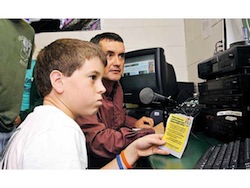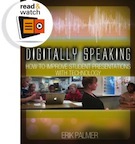Student Speaking Skills
by Erik Palmer
Recently I walked into a middle school and saw a bunch of students talking at lockers. I found the teacher and asked her what was going on. She told me the students were practicing their book reports.
In a week, she said, her students would be talking at classmates and making presentations – this was her way of preparing them. Had I slipped into a time warp?! Nearly 50 years ago, when I was in the 7th grade, I had to give a book report and practiced my “speech” in front of a locker.
Has nothing changed? Is this still the best way to practice? Is the old-school book report still the best way to share what we’ve learned with our classmates? No, no, and no.
Live online radio
For one thing, there are many ways for students to record and watch themselves and others. Digital tools can provide more feedback than a locker can. I may write about those in a future post.

Now, a teacher can send students to Spreaker instead of to the hallway and give them a much more engaging assignment with a much more worthwhile result. Instead of a three-to-five minute talk given to one class in one school, students are able to create something long-lasting and for a potentially huge audience.
Audience increases motivation. By replacing the report that only classmates hear, a show is created that can also be heard by parents, other classes around the country, and even grandparents far away. If we want to meet our students where they are, Spreaker probably accomplishes this better than the old book talks do.
Free and standards-friendly
Spreaker is free. It’s also fairly intuitive and easy to use. Perhaps most important, it not only increases student interest, engagement and skill building, it addresses curriculum expectations. The Common Core ELA/Literacy standards include speaking and listening (although we haven’t heard much about them to this point). Those standards require students to speak well and to add multimedia to presentations. Spreaker can help them learn how to master both of these objectives.
When education folks discuss 21st century skills, creativity, innovation and communication are near the top of list, and Spreaker addresses all three. You can retire the old paper book reports and give students a fun and challenging assignment that’s CCSS-friendly. Happy news for any standards-juggling teacher.
Getting started with Spreaker
To help you get started, I have created a video tutorial that shows you the basics of Spreaker.
You can find many other tools and recommended websites (with tutorials and student examples) in my book Digitally Speaking: How to Improve Student Presentations with Technology (Stenhouse Publishers, 2012), but this will get you started.
Teachers do not have to work with Spreaker very long before they get quite comfortable manipulating the site. More importantly, students quickly become adept at adding music and sound effects (they can watch the tutorial, too). In a fourth grade class I was working with, before I could get to a student who had a question, another student would often solve the issue.
Think about it: we never taught our students how to play Angry Birds. They figured it out on their own. The same will be true about Spreaker. Even the technophobic teacher will be surprised at how quickly students master recording, adding sounds and producing a show.
Some words of caution
Time after time, I watch a video created as the culmination to a great project only to be embarrassed for the students because of the poor quality of the speaking.
A teacher does not need to be a pro before incorporating Spreaker into lessons. Spreaker fits into any curricular area at any age. But let me give you this warning: Don’t hit the record button until the students are ready!
I favor sites that showcase speaking because oral communication is by far the number one language art. Now, with podcasts, Skype, FaceTime, video conferences and video cameras everywhere (and free YouTube accounts for the asking), our ability to speak well has become critically important.

If you watch critically, with a reasonably high standard in mind, I think you’ll agree. More often, though, we notice how cool the tool is and/or how cool the project was, and we ignore the fact that we are listening to verbal rough drafts.
I don’t accept, “Hey, they’re just kids so whatever. Isn’t the technology awesome, though?” I don’t think we should publish poor writing on our classroom blogs, and I don’t think we should post poor speaking on the Web either. The authors of the Common Core ELA standards apparently agree with me.
CCSS.ELA-Literacy.SL.6.4 – Present claims and findings, sequencing ideas logically and using pertinent descriptions, facts, and details to accentuate main ideas or themes; use appropriate eye contact, adequate volume, and clear pronunciation. (Grade 6)
A speaking tip: Adding life to the voice
I teach six-trait speaking to my students, and let me share one of traits here. A live show at Spreaker will be heard through small speakers. The most important point for a student speaker to remember is to add life to the voice. Speech that’s okay in person can be dreadfully dull through the laptop/tablet/smartphone speaker. Dull, awkward speech is painful to listen to and (with the possible exception of your teacher and your parents) will be turned off.
Teach students to add life to their voices and narrative with small attention-getting phrases:

That was the best concert ever!
You found it? Way to go!
Then work to add life to the show. Don’t go live (or save and post) with a run-on drone like
“PoohwasskippingtoEeyorzsowswitabloonbutitpopped.”
Insist upon, “Pooh was skipping to Eeyore’s house with a balloon. [happy voice] Unfortunately, the balloon popped. Oh bother. [sad voice]” Listen to examples of effective broadcast speech. Students will soon understand how to make what they say sound interesting. When their voices have life, you are ready to begin creating Spreaker broadcasts.
I’m sure you have some assignment you currently give to students that could turn into a Spreaker activity. Perhaps you offer it as an option: “Stand and deliver a talk to the class in two weeks, or create a radio show at the Spreaker website if you prefer.” I’m betting you’ll get more than a few takers. No matter which way you go, when you raise your expectations for spoken presentations and then add radio shows to your repertoire, the results will benefit all students.
After a first career in the world of commodity trading, Erik Palmer became a teacher committed to curriculum and instruction with real-world relevance — and to the belief that the ability to speak clearly and present effectively are important life skills. Today he is an educational consultant based in Denver, Colorado and the author of two books from Stenhouse Publishers, Well-Spoken (2011) and the recently published Digitally Speaking, an interactive online book about improving student presentations.





































1 Response
[…] this great article published on the MiddleWeb site, Erik talks about the importance of making public speaking a part of the classroom. He lists […]